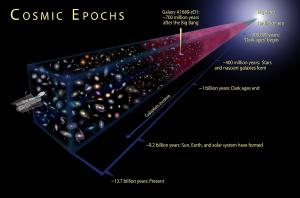Post
Private Time
1 February 2013
 NASA, ESA and A. Field (STScl)
NASA, ESA and A. Field (STScl)You are probably familiar with the basic idea of relativity, specifically the fact that a clock appears to tick more slowly if it is moving relative to you. This time dilation effect has been observed experimentally, and it has some interesting consequences.
When we talk about the age and history of the universe, we often use images such as the one above, which traces the evolution of the universe from the big bang to the present. These are cool illustrations, but they give the impression that the cosmos has a single universal age, and that it ticks and tocks uniformly everywhere. In reality there is no cosmic clock. Observed time depends upon your motion, thus two galaxies moving at different speeds will have a slightly different time from the big bang. The age of the universe will be different for each of them.
Lest you think calculating the age of the universe is therefore meaningless, keep in mind that it is perfectly valid to speak of the age of the universe from our vantage point, and in reality, the difference in ages is quite small. As an example, we can measure our speed relative to the cosmic microwave background, and it turns out to be about 630 kilometers per second, or about 1.4 million miles per hour. This is actually surprisingly fast, and it means from our viewpoint the universe appears younger than it would if we weren’t moving relative to the cosmic background, a difference of about 30,000 years. That might seem large, but it is only a difference of about one five-thousandth of a percent of the total age of the universe. Even our best measurement of the age of the universe is only accurate give or take 60 million years.
Still, this notion of relative time is true for everything, including us. If you were to walk by me while I sit on a park bench, your time would be slightly different from mine because of our relative motion. In essence we each have our own private time.